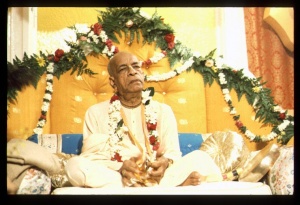SB 6.8.8-10: Difference between revisions
m (1 revision(s)) |
No edit summary |
||
| Line 1: | Line 1: | ||
{{info | {{info | ||
|speaker= | |speaker=Viśvarūpa | ||
|listener=Demigod King Indra and the Demigods | |listener=Demigod King Indra and the Demigods | ||
}} | }} | ||
[[Category:Srimad-Bhagavatam - Canto 06 Chapter 08|s08-10 ]] | |||
[[Category:Bhagavatam Verses Spoken by Visvarupa - Vanisource|060808]] | |||
<div style="float:left">'''[[Srimad-Bhagavatam]] - [[SB 6|Sixth Canto]] - [[SB 6.8: The Narayana-kavaca Shield|Chapter 8: The Nārāyaṇa-kavaca Shield]]'''</div> | |||
<div style="float:right">[[File:Go-previous.png|link=SB 6.8.7]] '''[[SB 6.8.7]] - [[SB 6.8.11]]''' [[File:Go-next.png|link=SB 6.8.11]]</div> | |||
{{RandomImage}} | |||
==== TEXTS 8-10 ==== | ==== TEXTS 8-10 ==== | ||
<div class="verse"> | |||
:nyased dhṛdaya oṁkāraṁ | |||
:vi-kāram anu mūrdhani | |||
:ṣa-kāraṁ tu bhruvor madhye | |||
:ṇa-kāraṁ śikhayā nyaset | |||
:ve-kāraṁ netrayor yuñjyān | |||
:na-kāraṁ sarva-sandhiṣu | |||
:ma-kāram astram uddiśya | |||
:mantra-mūrtir bhaved budhaḥ | |||
:savisargaṁ phaḍ-antaṁ tat | |||
:sarva-dikṣu vinirdiśet | |||
:oṁ viṣṇave nama iti | |||
savisargaṁ phaḍ-antaṁ tat | |||
sarva-dikṣu vinirdiśet | |||
oṁ viṣṇave nama iti | |||
</div> | </div> | ||
| Line 24: | Line 31: | ||
==== SYNONYMS ==== | ==== SYNONYMS ==== | ||
<div class="synonyms"> | |||
<div | ''nyaset''—should place; ''hṛdaye''—on the heart; ''oṁkāram''—the ''praṇava'', ''oṁkāra''; ''vi-kāram''—the syllable ''vi'' of ''viṣṇave''; ''anu''—thereafter; ''mūrdhani''—on the top of the head; ''ṣa-kāram''—the syllable ''sa''; ''tu''—and; ''bhruvoḥ madhye''—between the two eyebrows; ''ṇa-kāram''—the syllable ''ṇa''; ''śikhayā''—on the ''śikhā'' on the head; ''nyaset''—should place; ''vekāram''—the syllable ''ve''; ''netrayoḥ''—between the two eyes; ''yuñjyāt''—should be placed; ''na-kāram''—the syllable ''na'' of the word ''namaḥ''; ''sarva-sandhiṣu''—on all the joints; ''ma-kāram''—the syllable ''ma'' of the word ''namaḥ''; ''astram''—a weapon; ''uddiśya''—thinking; ''mantra-mūrtiḥ''—the form of the ''mantra''; ''bhavet''—should become; ''budhaḥ''—an intelligent person; ''sa-visargam''—with the ''visarga'' (ḥ); ''phaṭ-antam''—ending with the sound ''phaṭ''; ''tat''—that; ''sarva-dikṣu''—in all directions; ''vinirdiśet''—should fix; ''oṁ''—''praṇava''; ''viṣṇave''—unto Lord Viṣṇu; ''namaḥ''—obeisances; ''iti''—thus. | ||
</div> | </div> | ||
| Line 32: | Line 38: | ||
==== TRANSLATION ==== | ==== TRANSLATION ==== | ||
<div class="translation"> | |||
<div | |||
One must then chant the mantra of six syllables [oṁ viṣṇave namaḥ]. One should place the syllable "oṁ" on his heart, the syllable "vi" on the top of his head, the syllable "ṣa" between his eyebrows, the syllable "ṇa" on his tuft of hair [śikhā], and the syllable "ve" between his eyes. The chanter of the mantra should then place the syllable "na" on all the joints of his body and meditate on the syllable "ma" as being a weapon. He should thus become the perfect personification of the mantra. Thereafter, adding visarga to the final syllable "ma," he should chant the mantra "maḥ astrāya phaṭ" in all directions, beginning from the east. In this way, all directions will be bound by the protective armor of the mantra. | One must then chant the mantra of six syllables [oṁ viṣṇave namaḥ]. One should place the syllable "oṁ" on his heart, the syllable "vi" on the top of his head, the syllable "ṣa" between his eyebrows, the syllable "ṇa" on his tuft of hair [śikhā], and the syllable "ve" between his eyes. The chanter of the mantra should then place the syllable "na" on all the joints of his body and meditate on the syllable "ma" as being a weapon. He should thus become the perfect personification of the mantra. Thereafter, adding visarga to the final syllable "ma," he should chant the mantra "maḥ astrāya phaṭ" in all directions, beginning from the east. In this way, all directions will be bound by the protective armor of the mantra. | ||
</div> | </div> | ||
__NOTOC__ | |||
<div style="float:right; clear:both;">[[File:Go-previous.png|link=SB 6.8.7]] '''[[SB 6.8.7]] - [[SB 6.8.11]]''' [[File:Go-next.png|link=SB 6.8.11]]</div> | |||
__NOTOC__ | |||
__NOEDITSECTION__ | |||
Revision as of 07:21, 13 May 2021

A.C. Bhaktivedanta Swami Prabhupada
TEXTS 8-10
- nyased dhṛdaya oṁkāraṁ
- vi-kāram anu mūrdhani
- ṣa-kāraṁ tu bhruvor madhye
- ṇa-kāraṁ śikhayā nyaset
- ve-kāraṁ netrayor yuñjyān
- na-kāraṁ sarva-sandhiṣu
- ma-kāram astram uddiśya
- mantra-mūrtir bhaved budhaḥ
- savisargaṁ phaḍ-antaṁ tat
- sarva-dikṣu vinirdiśet
- oṁ viṣṇave nama iti
SYNONYMS
nyaset—should place; hṛdaye—on the heart; oṁkāram—the praṇava, oṁkāra; vi-kāram—the syllable vi of viṣṇave; anu—thereafter; mūrdhani—on the top of the head; ṣa-kāram—the syllable sa; tu—and; bhruvoḥ madhye—between the two eyebrows; ṇa-kāram—the syllable ṇa; śikhayā—on the śikhā on the head; nyaset—should place; vekāram—the syllable ve; netrayoḥ—between the two eyes; yuñjyāt—should be placed; na-kāram—the syllable na of the word namaḥ; sarva-sandhiṣu—on all the joints; ma-kāram—the syllable ma of the word namaḥ; astram—a weapon; uddiśya—thinking; mantra-mūrtiḥ—the form of the mantra; bhavet—should become; budhaḥ—an intelligent person; sa-visargam—with the visarga (ḥ); phaṭ-antam—ending with the sound phaṭ; tat—that; sarva-dikṣu—in all directions; vinirdiśet—should fix; oṁ—praṇava; viṣṇave—unto Lord Viṣṇu; namaḥ—obeisances; iti—thus.
TRANSLATION
One must then chant the mantra of six syllables [oṁ viṣṇave namaḥ]. One should place the syllable "oṁ" on his heart, the syllable "vi" on the top of his head, the syllable "ṣa" between his eyebrows, the syllable "ṇa" on his tuft of hair [śikhā], and the syllable "ve" between his eyes. The chanter of the mantra should then place the syllable "na" on all the joints of his body and meditate on the syllable "ma" as being a weapon. He should thus become the perfect personification of the mantra. Thereafter, adding visarga to the final syllable "ma," he should chant the mantra "maḥ astrāya phaṭ" in all directions, beginning from the east. In this way, all directions will be bound by the protective armor of the mantra.